2017 Peugeot 3008 Hybrid 4 engine
[x] Cancel search: enginePage 166 of 578
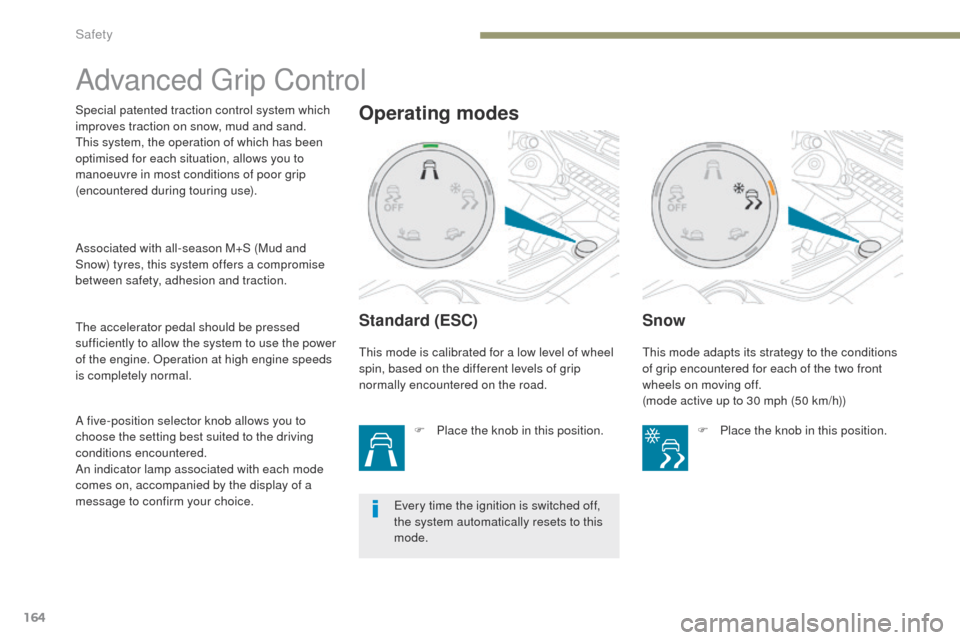
164
3008-2_en_Chap05_securite_ed01-2016
Advanced Grip Control
Standard (ESC)
F Place the knob in this position.
Snow
Special patented traction control system which
improves traction on snow, mud and sand.
This system, the operation of which has been
optimised for each situation, allows you to
manoeuvre in most conditions of poor grip
(encountered during touring use).This mode is calibrated for a low level of wheel
spin, based on the different levels of grip
normally encountered on the road.This mode adapts its strategy to the conditions
of grip encountered for each of the two front
wheels on moving off.
(mode active up to 30 mph (50 km/h))
F
P
lace the knob in this position.
The accelerator pedal should be pressed
sufficiently to allow the system to use the power
of the engine. Operation at high engine speeds
is completely normal.
Every time the ignition is switched off,
the system automatically resets to this
mode.
A five-position selector knob allows you to
choose the setting best suited to the driving
conditions encountered.
An indicator lamp associated with each mode
comes on, accompanied by the display of a
message to confirm your choice. Associated with all-season M+S (Mud and
Snow) tyres, this system offers a compromise
between safety, adhesion and traction.Operating modes
Safety
Page 168 of 578
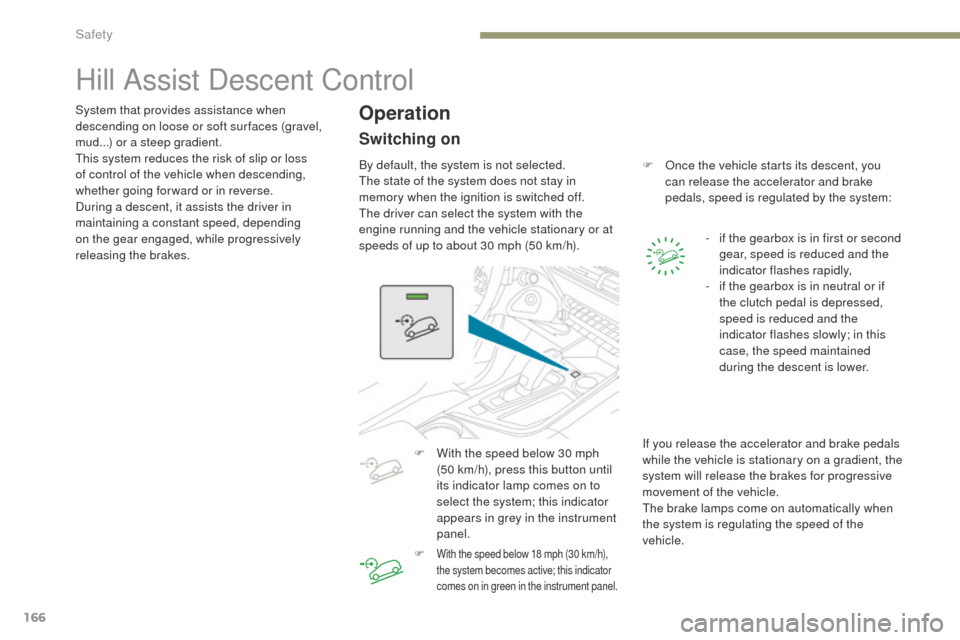
166
3008-2_en_Chap05_securite_ed01-2016
Hill Assist Descent Control
System that provides assistance when
descending on loose or soft sur faces (gravel,
mud...) or a steep gradient.
This system reduces the risk of slip or loss
of control of the vehicle when descending,
whether going forward or in reverse.
During a descent, it assists the driver in
maintaining a constant speed, depending
on the gear engaged, while progressively
releasing the brakes.Operation
By default, the system is not selected.
The state of the system does not stay in
memory when the ignition is switched off.
The driver can select the system with the
engine running and the vehicle stationary or at
speeds of up to about 30 mph (50 km/h).F
O nce the vehicle starts its descent, you
can release the accelerator and brake
pedals, speed is regulated by the system:
-
i
f the gearbox is in first or second
gear, speed is reduced and the
indicator flashes rapidly,
-
i
f the gearbox is in neutral or if
the clutch pedal is depressed,
speed is reduced and the
indicator flashes slowly; in this
case, the speed maintained
during the descent is lower.
Switching on
F With the speed below 30 mph (50 km/h), press this button until
its indicator lamp comes on to
select the system; this indicator
appears in grey in the instrument
panel.
F
With the speed below 18 mph (30 km/h),
the system becomes active; this indicator
comes on in green in the instrument panel.
If you release the accelerator and brake pedals
while the vehicle is stationary on a gradient, the
system will release the brakes for progressive
movement of the vehicle.
The brake lamps come on automatically when
the system is regulating the speed of the
vehicle.
Safety
Page 169 of 578
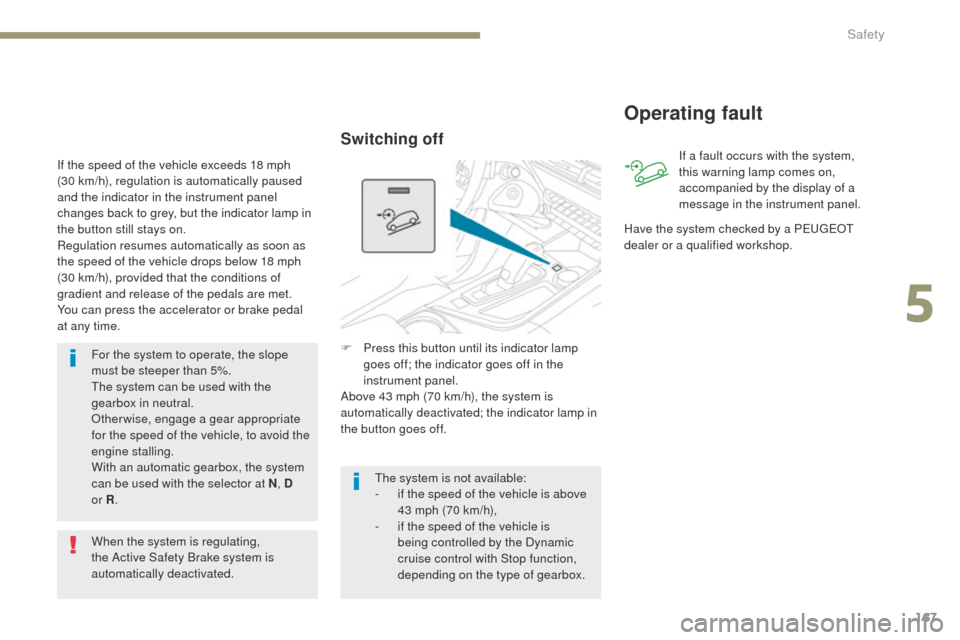
167
3008-2_en_Chap05_securite_ed01-2016
For the system to operate, the slope
must be steeper than 5%.
The system can be used with the
gearbox in neutral.
Otherwise, engage a gear appropriate
for the speed of the vehicle, to avoid the
engine stalling.
With an automatic gearbox, the system
can be used with the selector at N, D
or R .
If the speed of the vehicle exceeds 18 mph
(30
km/h), regulation is automatically paused
and the indicator in the instrument panel
changes back to grey, but the indicator lamp in
the button still stays on.
Regulation resumes automatically as soon as
the speed of the vehicle drops below 18 mph
(30 km/h), provided that the conditions of
gradient and release of the pedals are met.
You can press the accelerator or brake pedal
at any time.
Operating fault
If a fault occurs with the system,
this warning lamp comes on,
accompanied by the display of a
message in the instrument panel.
Have the system checked by a PEUGEOT
dealer or a qualified workshop.Switching off
F Press this button until its indicator lamp goes off; the indicator goes off in the
instrument panel.
Above 43 mph (70 km/h), the system is
automatically deactivated; the indicator lamp in
the button goes off.
The system is not available:
-
i
f the speed of the vehicle is above
43 mph (70 km/h),
-
i
f the speed of the vehicle is
being controlled by the Dynamic
cruise control with Stop function,
depending on the type of gearbox.
When the system is regulating,
the Active Safety Brake system is
automatically deactivated.
5
Safety
Page 172 of 578
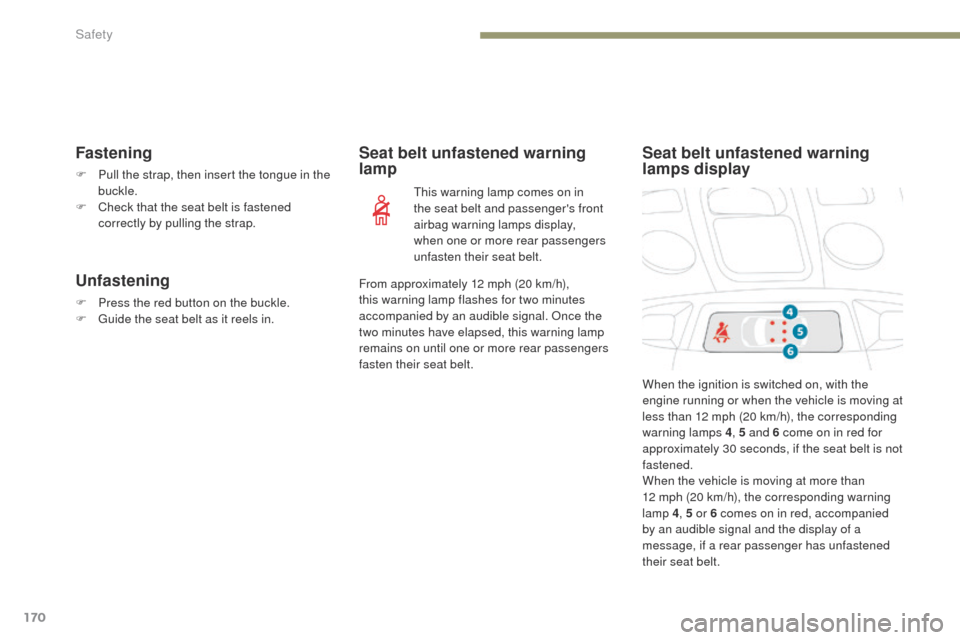
170
3008-2_en_Chap05_securite_ed01-2016
Fastening
F Pull the strap, then insert the tongue in the buckle.
F
C
heck that the seat belt is fastened
correctly by pulling the strap.
Unfastening
F Press the red button on the buckle.
F G uide the seat belt as it reels in. This warning lamp comes on in
the seat belt and passenger's front
airbag warning lamps display,
when one or more rear passengers
unfasten their seat belt.
Seat belt unfastened warning
lamp
Seat belt unfastened warning
lamps display
When the ignition is switched on, with the
engine running or when the vehicle is moving at
less than 12 mph (20 km/h), the corresponding
warning lamps 4
, 5 and 6 come on in red for
approximately 30 seconds, if the seat belt is not
fastened.
When the vehicle is moving at more than
12
mph (20 km/h), the corresponding warning
lamp 4 , 5 or 6 comes on in red, accompanied
by an audible signal and the display of a
message, if a rear passenger has unfastened
their seat belt.
From approximately 12 mph (20 km/h),
this warning lamp flashes for two minutes
accompanied by an audible signal. Once the
two minutes have elapsed, this warning lamp
remains on until one or more rear passengers
fasten their seat belt.
Safety
Page 197 of 578
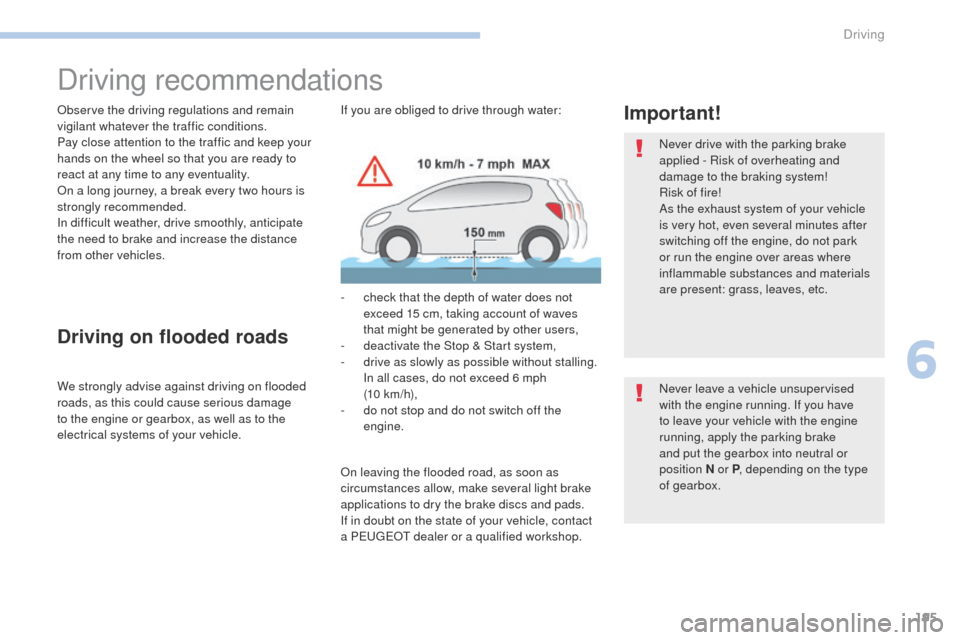
195
3008-2_en_Chap06_conduite_ed01-2016
Driving recommendations
Observe the driving regulations and remain
vigilant whatever the traffic conditions.
Pay close attention to the traffic and keep your
hands on the wheel so that you are ready to
react at any time to any eventuality.
On a long journey, a break every two hours is
strongly recommended.
In difficult weather, drive smoothly, anticipate
the need to brake and increase the distance
from other vehicles.
Driving on flooded roads
We strongly advise against driving on flooded
roads, as this could cause serious damage
to the engine or gearbox, as well as to the
electrical systems of your vehicle.
Important!If you are obliged to drive through water:
-
c
heck that the depth of water does not
exceed 15 cm, taking account of waves
that might be generated by other users,
-
d
eactivate the Stop & Start system,
-
d
rive as slowly as possible without stalling.
In all cases, do not exceed 6 mph
(10 km/h),
-
d
o not stop and do not switch off the
engine. Never drive with the parking brake
applied - Risk of overheating and
damage to the braking system!
Risk of fire!
As the exhaust system of your vehicle
is very hot, even several minutes after
switching off the engine, do not park
or run the engine over areas where
inflammable substances and materials
are present: grass, leaves, etc.
Never leave a vehicle unsupervised
with the engine running. If you have
to leave your vehicle with the engine
running, apply the parking brake
and put the gearbox into neutral or
position
N or P, depending on the type
of gearbox.
On leaving the flooded road, as soon as
circumstances allow, make several light brake
applications to dry the brake discs and pads.
If in doubt on the state of your vehicle, contact
a PEUGEOT dealer or a qualified workshop.
6
Driving
Page 198 of 578
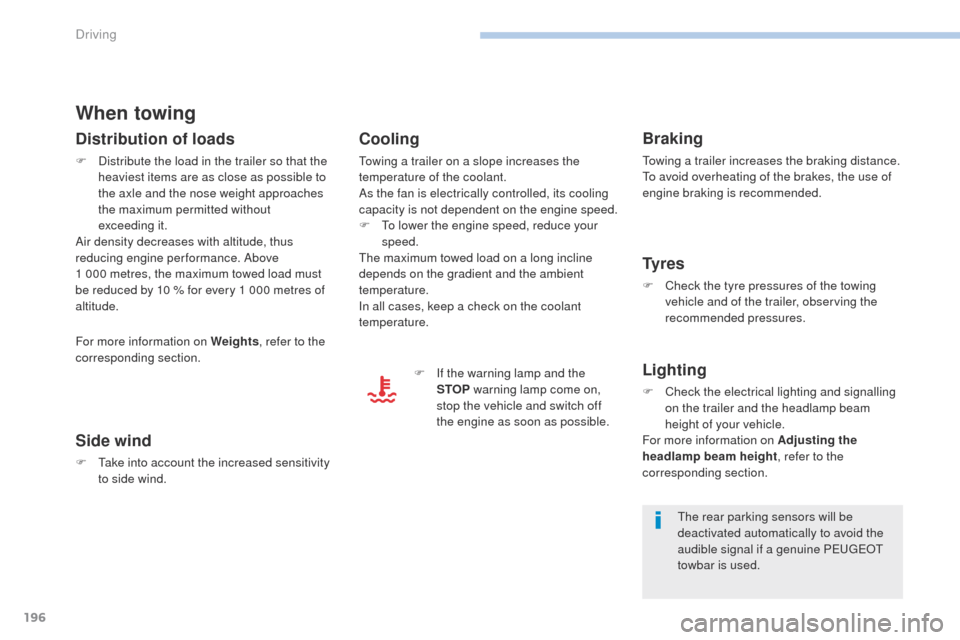
196
3008-2_en_Chap06_conduite_ed01-2016
When towing
Distribution of loads
F Distribute the load in the trailer so that the heaviest items are as close as possible to
the axle and the nose weight approaches
the maximum permitted without
exceeding
it.
Air density decreases with altitude, thus
reducing engine performance. Above
1
000 metres, the maximum towed load must
be reduced by 10
% for every 1 000 metres of
altitude.
Side wind
F Take into account the increased sensitivity to side wind.
For more information on Weights
, refer to the
corresponding section. F
I
f the warning lamp and the
STOP warning lamp come on,
stop the vehicle and switch off
the engine as soon as possible.
Braking
Towing a trailer increases the braking distance.
To avoid overheating of the brakes, the use of
engine braking is recommended.
Ty r e s
F Check the tyre pressures of the towing vehicle and of the trailer, observing the
recommended pressures.
Lighting
F Check the electrical lighting and signalling on the trailer and the headlamp beam
height of your vehicle.
For more information on Adjusting the
headlamp beam height , refer to the
corresponding section.
The rear parking sensors will be
deactivated automatically to avoid the
audible signal if a genuine PEUGEOT
towbar is used.
Cooling
Towing a trailer on a slope increases the
temperature of the coolant.
As the fan is electrically controlled, its cooling
capacity is not dependent on the engine speed.
F
T
o lower the engine speed, reduce your
speed.
The maximum towed load on a long incline
depends on the gradient and the ambient
temperature.
In all cases, keep a check on the coolant
temperature.
Driving
Page 199 of 578
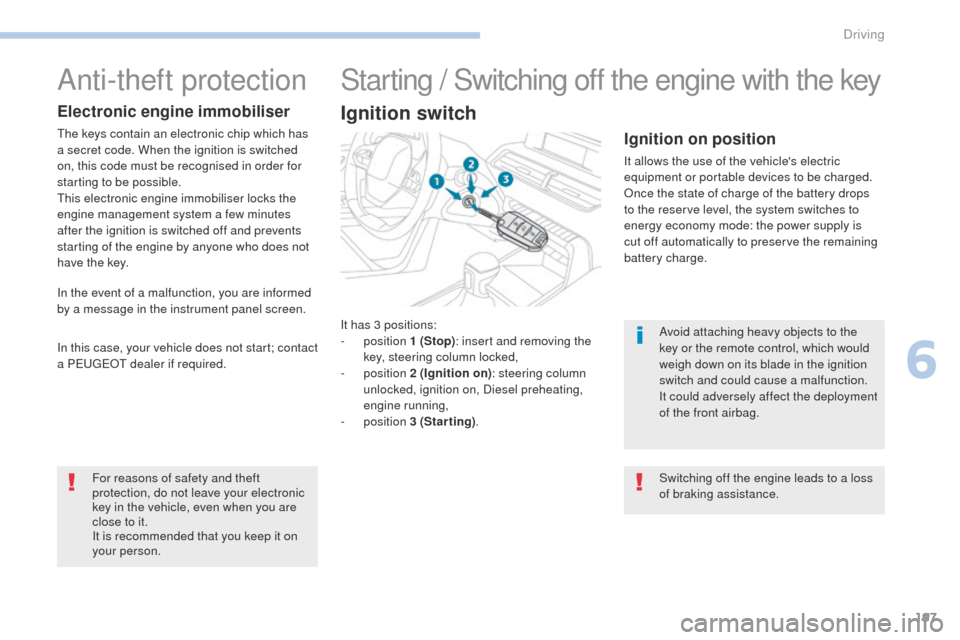
197
3008-2_en_Chap06_conduite_ed01-2016
It has 3 positions:
- position 1 (Stop): insert and removing the
key, steering column locked,
-
position 2 (Ignition on) : steering column
unlocked, ignition on, Diesel preheating,
engine running,
-
position 3 (Starting) .
Ignition on position
It allows the use of the vehicle's electric
equipment or portable devices to be charged.
Once the state of charge of the battery drops
to the reserve level, the system switches to
energy economy mode: the power supply is
cut off automatically to preserve the remaining
battery charge.
Starting / Switching off the engine with the key
Ignition switch
Avoid attaching heavy objects to the
key or the remote control, which would
weigh down on its blade in the ignition
switch and could cause a malfunction.
It could adversely affect the deployment
of the front airbag.
Switching off the engine leads to a loss
of braking assistance.
Anti-theft protection
In the event of a malfunction, you are informed
by a message in the instrument panel screen.
For reasons of safety and theft
protection, do not leave your electronic
key in the vehicle, even when you are
close to it.
It is recommended that you keep it on
your person.
Electronic engine immobiliser
The keys contain an electronic chip which has
a secret code. When the ignition is switched
on, this code must be recognised in order for
starting to be possible.
This electronic engine immobiliser locks the
engine management system a few minutes
after the ignition is switched off and prevents
starting of the engine by anyone who does not
have the key.
In this case, your vehicle does not start; contact
a PEUGEOT dealer if required.
6
Driving
Page 200 of 578
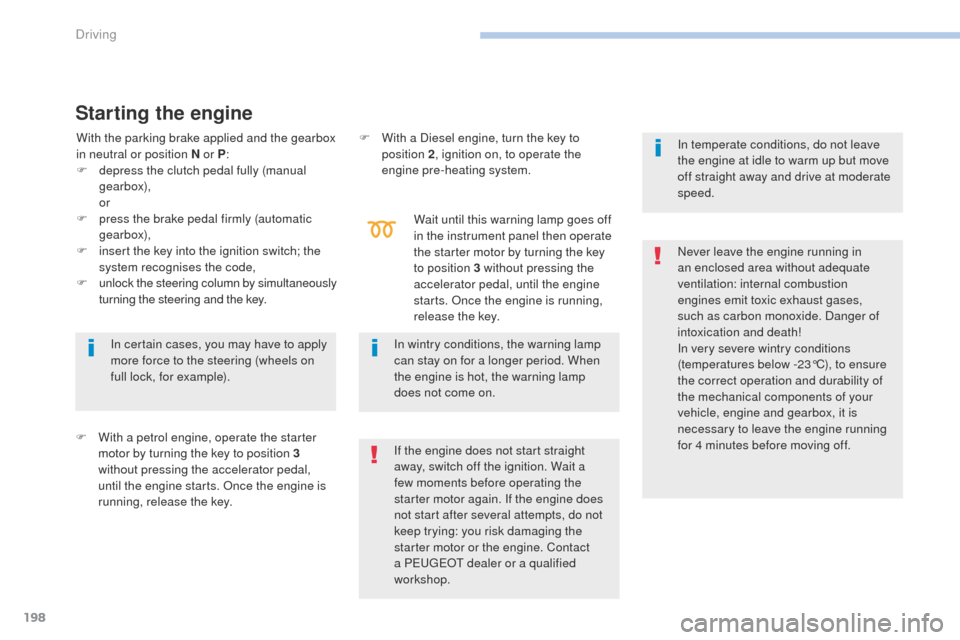
198
3008-2_en_Chap06_conduite_ed01-2016
Starting the engine
F With a petrol engine, operate the starter motor by turning the key to position 3
without pressing the accelerator pedal,
until the engine starts. Once the engine is
running, release the key. F
W
ith a Diesel engine, turn the key to
position 2 , ignition on, to operate the
engine pre-heating system.
Wait until this warning lamp goes off
in the instrument panel then operate
the starter motor by turning the key
to position 3 without pressing the
accelerator pedal, until the engine
starts. Once the engine is running,
release the key.
If the engine does not start straight
away, switch off the ignition. Wait a
few moments before operating the
starter motor again. If the engine does
not start after several attempts, do not
keep trying: you risk damaging the
starter motor or the engine. Contact
a PEUGEOT dealer or a qualified
workshop. Never leave the engine running in
an enclosed area without adequate
ventilation: internal combustion
engines emit toxic exhaust gases,
such as carbon monoxide. Danger of
intoxication and death!
In very severe wintry conditions
(temperatures below -23°C), to ensure
the correct operation and durability of
the mechanical components of your
vehicle, engine and gearbox, it is
necessary to leave the engine running
for 4 minutes before moving off.
In certain cases, you may have to apply
more force to the steering (wheels on
full lock, for example).
In wintry conditions, the warning lamp
can stay on for a longer period. When
the engine is hot, the warning lamp
does not come on.In temperate conditions, do not leave
the engine at idle to warm up but move
off straight away and drive at moderate
speed.
With the parking brake applied and the gearbox
in neutral or position N or P
:
F
d
epress the clutch pedal fully (manual
gearbox),
or
F
p
ress the brake pedal firmly (automatic
gearbox),
F
i
nsert the key into the ignition switch; the
system recognises the code,
F
u
nlock the steering column by simultaneously
turning the steering and the key.
Driving